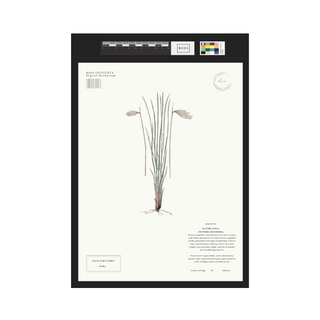

Vetiveria zizanioides, commonly known as vetiver, is native to the Indian subcontinent. It is believed to have originated in India, particularly in the region of South India. Vetiver is a type of perennial grass with long, narrow leaves and a complex root system that is highly valued for its aromatic and soil-stabilizing properties.
From its native region in India, vetiver cultivation has spread to other tropical and subtropical regions around the world, including countries in Southeast Asia, including Indonesia where we source ours from. It is also found in the Indian Ocean islands, and parts of Africa and the Americas.
Vetiver has a deep, earthy, and woody aroma with smoky and leathery undertones. It is often described as warm, rich, and sensual. Vetiver's scent can vary depending on its origin and the extraction method used, but it generally exudes a sense of grounding and sophistication.
Vetiver has a long-lasting and anchoring effect in fragrance compositions. It is known for its fixative properties, which help to prolong the overall scent of a perfume on the skin. It is a Base note found in our Earthy family.
Vetiver is highly versatile and can be used in a wide range of fragrance compositions. It blends well with other aromatic materials, adding depth and complexity to a perfume. Vetiver is often used in both masculine and feminine fragrances, and its scent can be adjusted to create different effects by combining it with other notes.
Vetiver is commonly used in various perfume categories, including woody, oriental, chypre, and even floral compositions. It is often used to create a solid foundation or to provide a natural and earthy touch to a fragrance.
Overall, vetiver is a prized ingredient in perfumery due to its complex and sophisticated scent profile. Its earthy and woody notes add depth and warmth to fragrances, making it a popular choice for creating luxurious and alluring compositions.
Vetiver has deep roots in Indian culture and is used in various ceremonial practices. In Ayurveda, the traditional Indian system of medicine, vetiver is considered a sacred plant and is used in rituals for its cooling and calming effects. It is also used in traditional perfumery and as a fragrant offering in Hindu temples.
In Bali, Indonesia, vetiver is used in religious ceremonies and rituals. The Balinese people weave vetiver grass into decorative baskets or ornaments that are used as offerings during temple ceremonies and other religious events. The fragrance of vetiver is believed to please the deities and invite their blessings.
Vetiver is used ceremonially in various African and Afro-Caribbean spiritual traditions. For example, in the Yoruba tradition of Ifá and Santería, vetiver leaves are used in rituals and offerings to deities (orishas) associated with the earth and fertility. Vetiver is believed to have protective and grounding properties in these practices.
Vetiver is used in Tibetan Buddhist rituals and offerings. It is often burned as incense or offered as part of prayer ceremonies. The fragrance of vetiver is believed to purify the environment and create a serene and focused atmosphere for meditation and spiritual practices.
Vetiver is used ceremonially by various indigenous cultures around the world, including those in the Americas, Africa, and the Pacific Islands. The specific rituals and cultural practices involving vetiver can vary widely among different tribes and communities. Vetiver may be used in healing ceremonies, purification rituals, or as part of offerings to the spirits or ancestors.
Vetiver is not only valued for its fragrance but also for its practical applications. The roots of the vetiver plant are often used for erosion control and soil stabilization due to their extensive network. The roots are also used in traditional medicine for their purported therapeutic properties.
Vetiver
- Unit price
- /per
Please note this product format is a small vial that contains roughly 20 drops of scent concentrate. This can be purchased à la carte but is intended to be used with our Perfume Kit.
SCENT SPECIFICATIONS
Latin Name: Vetiveria Zizaniodes
Extraction Method: Steam Distilled
Source: Root
Country of Origin: Indonesia
We are a natural perfumer; all of the scents in our library are derived from plants.
Adding product to your cart
Vetiveria zizanioides, commonly known as vetiver, is native to the Indian subcontinent. It is believed to have originated in India, particularly in the region of South India. Vetiver is a type of perennial grass with long, narrow leaves and a complex root system that is highly valued for its aromatic and soil-stabilizing properties.
From its native region in India, vetiver cultivation has spread to other tropical and subtropical regions around the world, including countries in Southeast Asia, including Indonesia where we source ours from. It is also found in the Indian Ocean islands, and parts of Africa and the Americas.
Vetiver has a deep, earthy, and woody aroma with smoky and leathery undertones. It is often described as warm, rich, and sensual. Vetiver's scent can vary depending on its origin and the extraction method used, but it generally exudes a sense of grounding and sophistication.
Vetiver has a long-lasting and anchoring effect in fragrance compositions. It is known for its fixative properties, which help to prolong the overall scent of a perfume on the skin. It is a Base note found in our Earthy family.
Vetiver is highly versatile and can be used in a wide range of fragrance compositions. It blends well with other aromatic materials, adding depth and complexity to a perfume. Vetiver is often used in both masculine and feminine fragrances, and its scent can be adjusted to create different effects by combining it with other notes.
Vetiver is commonly used in various perfume categories, including woody, oriental, chypre, and even floral compositions. It is often used to create a solid foundation or to provide a natural and earthy touch to a fragrance.
Overall, vetiver is a prized ingredient in perfumery due to its complex and sophisticated scent profile. Its earthy and woody notes add depth and warmth to fragrances, making it a popular choice for creating luxurious and alluring compositions.
Vetiver has deep roots in Indian culture and is used in various ceremonial practices. In Ayurveda, the traditional Indian system of medicine, vetiver is considered a sacred plant and is used in rituals for its cooling and calming effects. It is also used in traditional perfumery and as a fragrant offering in Hindu temples.
In Bali, Indonesia, vetiver is used in religious ceremonies and rituals. The Balinese people weave vetiver grass into decorative baskets or ornaments that are used as offerings during temple ceremonies and other religious events. The fragrance of vetiver is believed to please the deities and invite their blessings.
Vetiver is used ceremonially in various African and Afro-Caribbean spiritual traditions. For example, in the Yoruba tradition of Ifá and Santería, vetiver leaves are used in rituals and offerings to deities (orishas) associated with the earth and fertility. Vetiver is believed to have protective and grounding properties in these practices.
Vetiver is used in Tibetan Buddhist rituals and offerings. It is often burned as incense or offered as part of prayer ceremonies. The fragrance of vetiver is believed to purify the environment and create a serene and focused atmosphere for meditation and spiritual practices.
Vetiver is used ceremonially by various indigenous cultures around the world, including those in the Americas, Africa, and the Pacific Islands. The specific rituals and cultural practices involving vetiver can vary widely among different tribes and communities. Vetiver may be used in healing ceremonies, purification rituals, or as part of offerings to the spirits or ancestors.
Vetiver is not only valued for its fragrance but also for its practical applications. The roots of the vetiver plant are often used for erosion control and soil stabilization due to their extensive network. The roots are also used in traditional medicine for their purported therapeutic properties.
